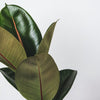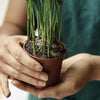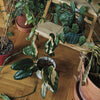Alocasia, tropical beauties with large leaves
A dominant plant with large leaves
Alocasia , in Czech Alocasia is a genus of plants from the Araceae family . These are medium-sized to massive herbs with a thick underground rhizome and massive leaves. Alocasia has over 70 species of cultivars, from robust to smaller species, and in the wild they are found exclusively in tropical and subtropical regions from India to southern China, Indochina and Southeast Asia to Australia and Oceania and most often grow in the undergrowth of moist forests or primeval forests.
Alocasia are evergreen plants that are grown exclusively as houseplants in our conditions , they can also be used in greenhouses or outdoor atriums protected from wind and sunlight. When the plant is young, it grows directly from the underground rhizome, which becomes massive over time, when it reaches a certain size, it can happen that the plant starts to lie down and bend due to its weight. If you want it to remain straight, it is recommended to provide it with indirect bright light from all sides so that the plant does not tend to lean behind the light.
Alocasias are very interesting in their size , shape and colors. For lovers of large leaves, it is a suitable houseplant, which is comparable to other large-leaved houseplants such as caladia, monsters, ficuses or strelicias. Let's take a look at what you should know about it before you take it home.

Photo: Alocasia Portodora also grows to large sizes
How to take care of her?
Alocasia is more suitable for more advanced growers for several reasons. It is a plant that really loves moisture, so it is a plant less suitable for apartments where it is dry and lacks at least natural humidity. At the same time, caution is in order with watering, transplanting and choosing a suitable site. On the other hand, if you follow a few tips, you will be rewarded with beautiful leaves and great growth, and even a beginner can handle the care .
Light conditions
It is not too light-demanding and will be satisfied even with a moderately shaded corner at home away from the window. Alocasia likes to reach for the light, so there is nothing abnormal if it does not grow straight up, but rather to the side, it is enough to rotate the plant once a week. The best location will naturally be diffused light from all sides or from above. Do not expose it to direct sunlight in the summer, as burns would form on the leaves. Otherwise, it tolerates full light well, east, north or west windows. It does not color as well in shadier places, it may happen that the leaves start to turn yellow over time and growth slows down. Of course, this will also affect the size of the leaves, in a shady place you will have smaller leaves.

Photo: Alocasia Frydek
Air temperature and humidity
Alocasias like warmth and humidity. Avoid cold drafts, especially in the winter months and locations where it would be exposed to drafts for a long time. In winter, the temperature should not drop below 18°C, rather we recommend a normal room temperature of around 24°C.
Alocasia is the most demanding of humidity . This tends to be a stumbling block when growing in dry homes and especially in winter, when it also gets hot. You can help it by regular misting with soft water , i.e. boiled or rain water. Do not use water straight from the tap, unsightly brown spots could start to form on the leaves. Once in a while you can also wipe the leaves with a wet napkin, but be careful! Be careful with the type of Alocasia, eg Alocasia Frydek or Alocasia Black Velvet have velvety leaves (with fine hairs) and in these types of plants you would probably destroy the leaf by wiping with a damp cloth. If you are a hi-tech grower, Alocasia will do very well with a room humidifier .

Photo: Alocasia Dragon Scale resembles the skin of a dragon in its structure.
How to water Alocasia
Alocasias are plants that love high humidity and heat, but when it comes to watering, they are plants that do not like waterlogged soil. Chronic waterers will only repay with their death. Of course, the size of the flowerpot, its material and location, the humidity in your apartment and, last but not least, the type of substrate in which the plant is planted must be taken into account. However, Alocasia requires a constantly moist substrate, but never too wet and must not stand in water . It is recommended to water more often, but after smaller doses and monitor the humidity of the substrate with your finger, with water at room temperature.
The correct condition of the substrate is when the bottom layer of the substrate is moist and the top layer of the substrate is dry. If the soil is overwatered, the roots and leaves rot, and the entire leaves begin to turn yellow very quickly.
Hydroponics, yes or no?
Definitely yes. Like all other types of plants from the "Aroid" genus, Alocasia is very well grown in hydroponics or semi-hydroponics. However, if you decide to convert a plant that you already have in the substrate at home into hydroponic cultivation, be careful. The transfer of plants from substrate to water is fatal for many plants and takes time. The plant may even die. For better results, it is recommended to grow young plants this way.
A tip for hydroponic growing. If you decide to convert your Alocasia from a regular substrate to hydro cultivation, I have proven that even a larger Alocasia will survive without major damage, however, it is important to clean the roots very thoroughly from all substrate residues, take a good shower and leave them immersed in clean water for several weeks so that the plant acclimatized and developed "water roots". It will probably happen to you that the outermost large leaves fall off - this is normal, don't worry, the Alocasia will offend again, peel them all at the root of the plant so that there is no remnant of the leaf, it would rot and form mold in the water.
- Martin
Suitable substrate
The substrate should be airy and light with slight acidity. It is recommended to mix e.g. peat with a regular substrate, mix it with pine bark or coconut flakes and add an appropriate amount of perlite for overall aeration. At the bottom of the flower pot, make drainage from expanded clay , which will help drain residual water and allow the roots to breathe better. In our e-shop, you can also purchase a directly mixed substrate for aroids , which is also suitable for Alocasias. If you decide not to overdo it with the choice of substrate, your Alocasia will do well even in a normal substrate for houseplants, but keep in mind that they do not benefit from overwatering, at least mix the substrate with perlite.

Photo: Alocasia zebrina boasts striped stems resembling a zebra.
Transplantation and propagation
You don't need to transplant the plant often. For younger plants, it is suitable once a year around March with the arrival of spring, and for older plants approximately once every 2 to 3 years. Decide according to the condition of the substrate and the root system. If the roots seem to be sticking out in all directions, it's time to transplant.
Alocasia is more difficult to reproduce. The most common method is bunch separation . If of course you grow one. Alocasia sprouts new "tubers" shoots only under good conditions and of a certain size. If this happens, carefully cut it off with the root and you have a second plant. In the case of tubers, just carefully remove them from the substrate and you can let the tubers grow in a closed hothouse.
Blooming
Like other plants of this species, they have quiver-like flowers, which are rarely seen in our conditions.
Diseases and pests
Alocasia, like other plants, can suffer from pests. This most often happens in a dry environment, when the plant is more susceptible. Most often, weevils, weevils or other parasites can appear in the substrate. With long-term exposure to the sun and drafts, the leaves suffer from brown or dry spots that cause the entire leaf to fall. Don't be afraid to cut off the entire leaf in such a case, Alocasia soon puts on a new leaf and tends to regrow well from the rhizomes.
Be careful, it's poisonous!
Alocasia is a poisonous indoor plant, so be careful around small children or animals. Although it is used in herbalism in Chinese medicine, we better be careful at home, even when transplanting. Contact with the juice that flows from the root or leaves during mechanical damage can cause an unpleasant rash on the skin.
The most famous species of Alocasia
Among the most common species of Alocasia is Alocasia Polly with its very distinctive dark leaf, firm structure and white veining. It is most often found in flower shops. Another very common species is Alocasia Wentii , with a darker green color and purple lower leaves, it reaches an impressive size and grows quite quickly. And other well-known species are also Alocasia Portodora or Alocasia macrorrhiza Stingray
Among the Alocasia you will also find interesting species with atypically narrow leaves. E.g. Alocasia Longiloba or the attractive Alocasia Lauterbachiana . Also worth mentioning is the very non-traditional collectible hybrid Alocasia Brancifolia Pink Passion , which in its appearance is strikingly reminiscent of Philodendron Xanadu and Alocasia Zebrina . This plant is very special because it was introduced to the market quite recently and you won't find it anywhere in the wild! The Alocasia Dragon Scale , which by its color and structure resembles a real dragon, can make a special impression on you!
Among the popular, relatively expensive plants that are classified as rare species is Alocasia Melo , which has very hard leaves, they could almost seem artificial to someone with a grayish shade and a distinct structure. Alocasia Frydek with its fresh green color and velvety leaves and white veins. Her younger sister Alocasia Frydek Variegata , which ranks among the true rarities, is much more interesting, unfortunately a very difficult to find plant.

Author: Martin Seidl
-
Posted in
Péče o pokojovky





